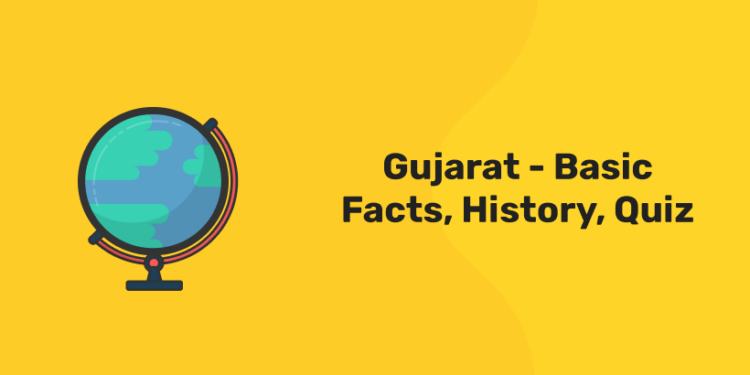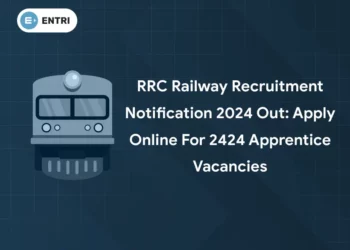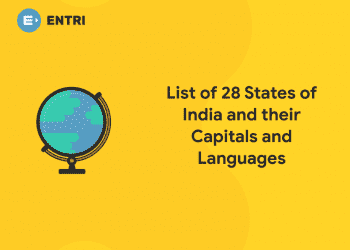Table of Contents
Gujarat is an Indian state on the western shore of the Arabian Sea. It encompasses the entire Kathiawar Peninsula (Saurashtra) as well as the neighbouring mainland area. Pakistan borders the state to the northwest, and the Indian states of Rajasthan, Madhya Pradesh, and Maharashtra border it to the north, east, and southeast. Gujarat also shares a small piece of its southeastern border with the Indian union territory of Dadra and Nagar Haveli, as well as the Arabian Sea, which surrounds the Indian union territory of Daman and Diu. Gujarat’s coastline is 992 miles (1,596 kilometres) long, with no part of the state more than 100 miles (160 kilometres) from the sea.
Gandhinagar, the state capital, is situated on the outskirts of Ahmadabad (Ahmedabad), the state’s largest city and one of India’s most important textile centres. Mohandas (Mahatma) Gandhi set up his Sabarmati ashram (Sanskrit: ashrama, “retreat” or “hermitage”) in Ahmadabad as a base for his anti-British activities.
In the 8th and 9th centuries CE, the Gurjara (a Hun subtribe) dominated the area, giving the state its name. The state took on its current shape in 1960, when the former Bombay state was partitioned into Maharashtra and Gujarat based on language.
History of Gujarat
Gujarat’s Stone Age settlements along the valleys of the Sabarmati and Mahi rivers in the state’s eastern portion date back hundreds of thousands of years. The establishment of a historical record is linked to the spread of the Indus (Harappan) civilization, which flourished in the 3rd and 2nd millennia BCE. The civilization’s centres have been discovered in Lothal, Rangpur, Amri, Lakhabaval, and Rozdi (mostly in the Kathiawar Peninsula).
Emperor Ashoka carved edicts on a rock in the Girnar Hills of the Kathiawar Peninsula, demonstrating the Mauryan dynasty’s supremacy over the area by the 3rd century BCE (c. 250 BCE). After the Mauryan empire fell apart (130–390 CE), Gujarat was controlled by the Shakas (Scythians), or western Kshatrapas. Gujarat’s Stone Age settlements along the valleys of the Sabarmati and Mahi rivers in the state’s eastern portion date back hundreds of thousands of years. Mahakshatrapa Rudradaman, the greatest of the Shaka kings, established his rule over Saurashtra (roughly equal to the Kathiawar Peninsula) and Kachchh, as w Gujarat’s Stone Age settlements along the valleys of the Sabarmati and Mahi rivers in the state’s eastern portion date back hundreds. The spread of the Indus (Harappan) civilization, which flourished in the 3rd and 2nd millennia BCE, is linked to the formation of a historical record. Lothal, Rangpur, Amri, Lakhabaval, and Rozdi have all been discovered as civilisation centres (mostly in the Kathiawar Peninsula). as well as other areas in what are now the states of Madhya Pradesh and Rajasthan, as well as the neighbouring province of Malwa.
From the late 4th to the late 5th century, Gujarat was a part of the Gupta empire, until the Maitraka dynasty of the kingdom of Valabhi took over and ruled Gujarat and Malwa for three centuries. Valabhipura (on the Kathiawar Peninsula’s eastern shore) was a major Buddhist, Vedic, and Jain research centre. In the 8th and 9th centuries, the Gurjara-Pratiharas (the imperial Gurjaras of Kannauj) succeeded the Maitraka dynasty, and the Solanki dynasty came after them. Gujarat’s borders were pushed to their furthest extent during the Solankis’ rule, and substantial progress was made in the fields of economics and culture.
The most well-known Solanki rulers are Siddharaja Jayasimha and Kumarapala. In around 1299, Al al-Dn Khalj, the Sultan of Delhi, conquered Karnadeva Vaghela, the founder of the subsequent Vaghela dynasty, and Gujarat fell under Muslim control. Amad Shah, Gujarat’s first sovereign monarch, founded Ahmadabad (1411). By the end of the 16th century, the Mughals had taken control of Gujarat. Their authority over the territory continued until the mid-eighteenth century, when the Marathas acquired control of the state.
Gujarat was taken over by the British East India Company in 1818. The region became a British province during the Indian Mutiny of 1857–58, and was divided into Gujarat province, which comprises around 10,000 square miles (26,000 square kilometres), and other local states (including Saurashtra and Kachchh). After India’s independence in 1947, Gujarat was annexed by Bombay state, and the province was expanded in 1956 to encompass Kachchh and Saurashtra. On May 1, 1960, India’s Bombay state was separated into Gujarat and Maharashtra.
In April 1965, fighting broke out in the Rann of Kachchh, a territory that had long been a source of conflict between India and Pakistan. A cease-fire was announced on July 1st, and the case was sent to an international tribunal for arbitration. In 1968, the tribunal made a judgement that gave India nine-tenths of the land and Pakistan one-tenth. Gujarat was once again immersed in chaos in 1985. Proposed revisions to Scheduled Castes concessions started the disturbance, which swiftly developed into five-month-long riots between Muslims and Hindus. In January 2001, a devastating earthquake devastated the state, with the epicentre in Bhuj, Kachchh district.
Attempt free GK Quiz! Download Entri App
Cultural Life of Gujarat
Much of Gujarat’s culture is influenced by the mythology surrounding the Hindu deity Krishna (an incarnation of the god Vishnu) as told in the Puranas, a form of Hindu holy book. The popular dance known as garba has current versions of the earlier rasnritya and raslila dance traditions honouring Krishna. During the Navratri celebration (September–October), which honours the divine feminine, dancers circulate in a circle, chanting and maintaining time by clapping their hands. During Navratri, Bhavai, a type of popular, rural, comedic theatre that depicts various aspects of rural life, is also regularly performed. In bhavai, men play all of the roles, both male and female.
The Hindu god Shiva’s religion, Shaivism (Shivaism), has long thrived in Gujarat, as has Vaishnavism (Vishnu’s worship), from which has emerged not only the cult of bhakti (devotion), but also a great repertory of poetry and music. Narsinh (or Narasimha) Mehta, a 15th-century poet who popularised the bhakti cult; Mira Bai, a 16th-century Rajput princess who renounced her royal title and composed bhajans (devotional songs); Premanand, an 18th-century poet and writer; and Dayaram, an 18th-century composer of songs who popularised the bhakti cult.
n the Jain tradition, the writings of Hemacandra, a prolific 12th-century author, are still treasured. Hemacandra wrote a number of textbooks on Indian philosophy as well as Sanskrit and Prakrit grammatical studies. He also wrote a Jain-inspired epic history of the world and other poems.
Mahatma Gandhi is also considered one of the state’s most prolific authors. Ghandi’s Gujarati works, which are recognised for their vibrancy and simplicity, have influenced modern Gujarati prose significantly.
Some interesting facts about Gujarat
- Gujarat is originated from the Gurjar nation in Sanskrit (Gurjar-Rashtra). Prior to the Mughal Empire, Gujarat was known as Gurjaratra (country ruled or defended by the Gurjars) or Gurjarabhumi (land of the Gurjars).
- In comparison to any other Indian state, Gujarat has the longest coastline.
- Gujarat has seventeen airports, making it the state in India with the most operational airports.
- Gujarat was one of the Indus Valley Civilization’s most important centres. It features significant Indus Valley ancient metropolises like as Lothal, Dholavira, and Gola Dhoro. The ancient city of Lothal was the site of India’s first port.
- It is renowned as the “Jewel of the West” in the area.
- Gujarat is India’s safest state. It has the lowest crime rate in India, at 8.2, even after the sectarian violence of 2002.
- Ahmedabad was named the world’s third fastest growing city by Forbes magazine in 2010.
- Gujarat’s first capital was Ahmedabad, which was shifted to Gandhinagar in 1970.
- Gandhinagar is Asia’s most environmentally friendly capital city.
- Did you know that Gujarat has the largest percentage of vegetarians in India compared to any other state?
- Gujaratis own nearly 17,000 hotels and motels in the United States, accounting for over half of the country’s economy lodgings.
- The state-owned Wide Area Network connects 26 districts and 225 talukas with 12,000 nodes, making it the largest IP-based ICT network in the Asia Pacific Region and the second largest in the world.
- Gujarat is India’s only state with a 2,200-kilometer-long gas system.
- Gujarat is one of India’s wealthiest states, with a per-capita GDP that is 3.2 times the national average.
- Gujarat ranks first in the country for gas-fired thermal electricity generation, with a market share of more than 8%, and second in nuclear power generation, with a market share of more than 1%.
Gujarat General Knowledge Quiz
Q.1.Gujarat is bordered to the south by the state of….
- Madhya Pradesh
- Maharashtra
- Rajasthan
- Arabian Sea
Answer: Maharashtra
Q.2.Which industry is well-known in Surat?
- Textile
- Tourism
- Coal
- Oil & gas
Answer: Textile
Q 3.Gujarat’s total number of districts?
- 28
- 33
- 35
- 39
Answer: 33
Q.4.Which of Gujarat’s rivers is the longest?
- Tapi
- Narmada
- Sabarmati
- Mahi
Answer: Narmada
Q.5.Which district has the largest forest area in Gujarat
- Dang
- Gir Somnath
- Tapi
- Amreli
Answer: Dang
Q.6.When did the Sabarmati Ashram in Gujarat get started?
- 1917
- 1919
- 1920
- 1922
Answer: 1917
Q.7.Gujarat is the world’s leading producer of?
- Rice
- Milk
- Wheat
- Mango
Answer: Milk
Q.8.Which of the following Prime Minister is from Gujarat?
- Lal Bahadur Shastri
- Jitender Singh
- Charan Singh
- Morarji Desai
Answer: Morarji Desai
Q.9.Where is the CB Patel International Cricket Stadium?
- Surat
- Kutch
- Junagadh
- Rajkot
Answer: Surat
Q.10.Gujarat formation day
- 01 May
- 01 January
- 01 November
- 01 March
Answer: 01 May














